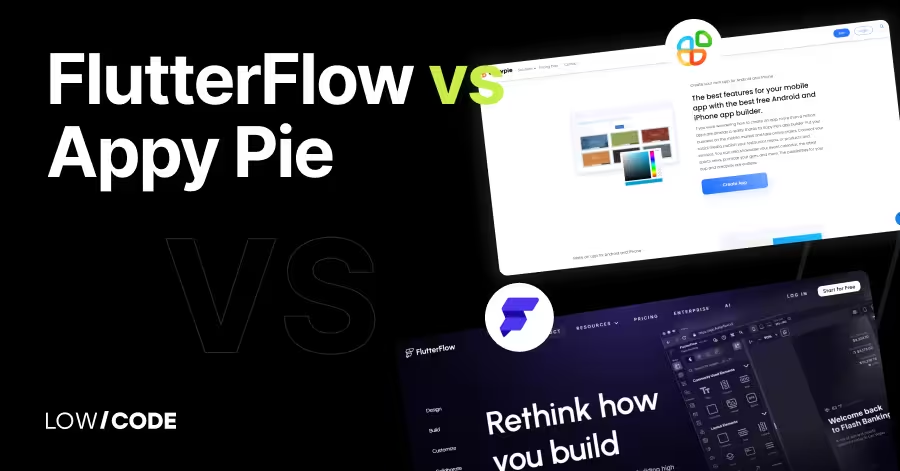How scalable is FlutterFlow? Scalability Best Practices
10 min
read
All you need to know about building scalable apps on FlutterFlow. Learn what sets this no-code platform apart and the best practices to follow.Flutterflow scalability

Flutterflow is a powerful tool for building cross-platform applications with minimal coding. But how does it handle scalability, one of the most important aspects of any modern app? In this blog post, we will explore some of the features that Flutterflow offers to help you scale your app to millions of users.
TL;DR
Flutterflow is a platform that enables you to create scalable apps without coding. It uses Firebase as the backend for your data and logic, Flutter as the framework for your UI and performance, and Dart as the language for your code. You can also export your app as a Flutter project and extend it with any feature you want. However, you should also be aware of some of the limitations and trade-offs that come with using Flutterflow for scalability, and how they may affect your app development process.
What is scalability?
Scalability is a critical concept when it comes to app development. It refers to the ability of a system, application, or platform to handle an increasing amount of work, such as user requests or data, without compromising its performance or functionality. In essence, it's about a system's capacity to grow and adapt as demand rises.
But, why is scalability so important? Let’s break this down:
- Meeting user demand: After an app is released to the public, it starts getting traction and will often face a surge in user traffic. Scalability ensures that your app can handle these increasing usage, without crashing or slowing down.
- Cost efficiency: Scalable apps are cost-efficient. They can optimize resource usage, and reduce the need for constant hardware or infrastructure upgrades as your user base expands.
- Future-proofing: Scalable apps can adapt to evolving technologies and user expectations, extending the app's lifespan. Also, a scalable app will be built with future upgrades in mind and a course of action to follow when those upgrades are needed.
- Competitive advantage: Scalable apps are better positioned to compete in the market. They can adapt to changing user requirements and outperform less scalable alternatives.
- Reliability: Scalable apps are generally more reliable. They have redundancy and failover mechanisms in place to maintain service availability even in the face of hardware or network failures.
- Global reach: Scalability is vital for apps with global aspirations. It allows you to serve users from different parts of the world without significant latency or downtime issues.
We should also cover some of the possible negative scenarios. An app built without scalability considerations can suffer from structural problems that need costly fixes, or in the worst case, a complete rebuild. Here's why:
- Technical debt: Apps that are not designed for scalability often accumulate technical debt, which is the cost of postponing necessary work on the codebase. This debt can result in higher maintenance costs and more time-consuming upgrades.
- Limited growth: Non-scalable apps are constrained by their existing architecture, making it difficult to accommodate new features, adapt to changing user demands, or leverage emerging technologies.
- User experience issues: Inflexible apps may struggle to provide a seamless user experience during traffic spikes, leading to user dissatisfaction, lost revenue, and potential damage to your brand's reputation.
Flutterflow: a technical overview
FlutterFlow is a robust visual development platform that simplifies the process of creating web and mobile applications. It’s a platform that simplifies app development as a whole: design, prototype, and deployment are much more efficient thanks to its no-code approach.
Here's a brief overview of how FlutterFlow works:
- Visual development: FlutterFlow follows a low-code or no-code approach, allowing developers to design applications visually. It provides a drag-and-drop interface for building user interfaces, enabling you to create screens and design elements without writing extensive code.
- Responsive design: The platform allows you to build responsive apps. This means apps that adapt to various screen sizes and orientations, ensuring a consistent user experience across different devices.
- Component-based: FlutterFlow is based on a component-based architecture. Developers can create reusable components like buttons, forms, or custom widgets, which can be incorporated into various parts of the app for a consistent design and efficient development process.
- Backend integration: FlutterFlow integrates with popular backend services, allowing developers to connect their applications to databases, APIs, and other data sources.
- Code generation: While FlutterFlow emphasizes visual development, it also generates clean, production-ready code in Dart, the programming language used by the Flutter framework. Your app will be fully customizable because it can be extended with custom code when necessary.
Now, let's take a look at the technologies behind FlutterFlow's functionalities:
- Flutter: At its core, FlutterFlow is built on the Flutter framework, an open-source UI toolkit developed by Google. Flutter allows developers to create natively compiled applications for mobile, web, and desktop from a single codebase.
- Dart: Dart is the programming language used for developing Flutter applications. FlutterFlow generates Dart code that closely follows Flutter best practices, ensuring that the codebase is maintainable and efficient.
- Firebase: Firebase is often used as a backend option for apps built on FlutterFlow. It provides features like authentication, real-time databases, and cloud functions. It simplifies the process of creating serverless applications.
- HTML, CSS, and JavaScript: For web applications, FlutterFlow generates HTML, CSS, and JavaScript to create web-compatible code. Thanks to this, it’s possible to deploy your app on various web hosting platforms.
FlutterFlow offers developers an integrated and efficient environment for designing, prototyping, and launching applications, all while ensuring scalability and flexibility for future growth and development.
Flutterflow scalability features
First, let's talk about data. Flutterflow uses Firebase as the backend for your app, which means you can store and sync your data across different devices and platforms. Firebase is a cloud service that provides various features such as authentication, database, storage, hosting, analytics, and more. Firebase scales automatically as your app grows, so you don't have to worry about managing servers or infrastructure. You only pay for what you use, and you can easily monitor your app's performance and usage from the Firebase console.

Another benefit of using Firebase is that it supports real-time data updates: whenever your data changes in the database, your app will reflect those changes instantly. This is great for apps that need to show live data, such as chat, social media, or gaming apps. You can also use Firebase Cloud Functions to trigger custom logic when certain events happen in your database, such as sending notifications, processing payments, or integrating with third-party services.
Another feature of Flutterflow that helps with scalability is its support for state management. State management is the process of managing the data and logic of your app across different screens and components. Flutterflow allows you to choose from different state management options, such as Provider, Riverpod, GetX, and Bloc. These options enable you to separate your UI from your business logic and make your code more modular, reusable, and testable. State management also helps you optimize your app's performance by reducing unnecessary rebuilds and updates.

Flutterflow also helps you improve your app performance by providing tools such as code splitting, lazy loading, and tree shaking. Code splitting allows you to divide your app into smaller chunks that are loaded on demand, reducing the initial download size and startup time of your app. Lazy loading enables you to load only the resources that are needed for the current screen or feature, saving bandwidth and memory. Tree shaking removes any unused code from your app, making it smaller and faster.
Finally, let's talk about adding new features to your project. Flutterflow allows you to add various features to your app without coding, such as navigation, forms, lists, maps, charts, media players, and more. You can also customize the look and feel of your app by choosing from different themes, fonts, colors, icons, and widgets.
But what if you want to add more advanced or custom features to your app? No problem! A standout of Flutterflow that enhances scalability is its ability to generate clean and readable code. Flutterflow generates code that follows the best practices and conventions of Flutter and Dart. The code is well-structured, formatted, documented, and easy to understand and modify.

So, you can export your code from Flutterflow and continue working on your app in your preferred IDE or editor. This gives you full control over your code and allows you to add more features or functionalities that are not available in Flutterflow. You can also use any of the thousands of packages and plugins that are available for Flutter from pub.dev or other sources.
Limitations and trade-offs
We mentioned before that of the benefits of Flutterflow using Firebase and Firebase Cloud Functions. However, Firebase also has some limitations that you should be aware of. For example, Firebase has a limit on the number of concurrent connections that your app can have at any given time. This limit depends on the plan that you choose for your Firebase project, and it can range from 100 to 200,000 connections. If your app exceeds this limit, some of your users may experience errors or delays when accessing your app.
Another limitation of Firebase is that it does not support complex queries or transactions on your data. This means that if you want to perform operations such as filtering, sorting, aggregating, or joining your data, you may need to use additional tools or libraries such as Algolia or Firestore Extensions. You may also need to structure your data in a way that optimizes performance and scalability, such as denormalizing or flattening your data.
Flutter has some trade-offs that you should consider when scaling your app. For example, Flutter does not support dynamic code loading or reflection, which means that you cannot load new code or features at runtime without rebuilding your app. This may limit your ability to update or customize your app without requiring users to download a new version.
Another trade-off of Flutter is that it does not use the native UI components of each platform, but rather renders its own widgets using its own engine. This means that your app may not look or feel exactly like a native app on each platform, and it may not support some platform-specific features or integrations. You may need to use platform channels or plugins to access native functionality or services from your Flutter app.
We’ve covered that Flutterflow lets you export your app as a Flutter project that you can open in any IDE or code editor of your choice. You can then modify the code or add new functionality using Dart, the programming language that Flutter uses.
However, exporting your app as a Flutter project also has some implications that you should be aware of. For example, once you export your app, you will no longer be able to use Flutterflow's interface to make changes to your app. You will have to use code to modify your app's features, UI, or logic. You will also have to manage your own version control, testing, and deployment processes for your app.
Another implication of exporting your app is that you may need to learn more about Flutter and Dart to be able to extend your app with new features or functionality. You may also need to follow the best practices and guidelines for Flutter development, such as using state management, testing, debugging, and documentation tools. You may also need to keep your app updated with the latest versions of Flutter and fix any issues or bugs that may arise.
While these constraints can pose challenges, they aren't insurmountable. At LowCode Agency, we specialize in optimizing no-code and low-code platforms like FlutterFlow to meet your unique business needs. Book your free consultation now!
Case studies
- Ab.Money
Ab.Money is a meditation and mindset app created for Alexandra Belliakova (Sasha Belaire), available on both the App Store and Google Play Store. The app's features include original meditations, a custom audio player, video courses, daily tarot cards, and an affirmations feature for daily motivation.

The development team initially used another no-code tool to collaborate with Alexandra but quickly encountered scalability limitations as their user base grew, hitting around 4,000 users. The team decided to transition to FlutterFlow, capitalizing on its custom function capabilities, seamless third-party software integration, and effective collaboration tools to tackle these challenges and bring Ab.Money to life with greater scalability and efficiency.
Ilya, co-founder of Appful.Pro, highlighted the factors that led them to choose FlutterFlow:
"We realized that we can't scale quickly due to limitations of Adalo at around 4000 users, and our client wanted features that could not be done with this tool, so I switched to FlutterFlow." "I would say 80-90% of the app we built using FlutterFlow's native features."
Flutterflow Apps Examples: The 5 Best No-code Apps Built using FlutterFlow
Best practices for scaling with FlutterFlow

Optimize images
Optimizing images is a fundamental aspect of improving your app's performance and scalability. Large image files can significantly slow down your app. Here's how to do it:
- Compression: Compress your images to reduce their file size while maintaining acceptable quality. Tools like ImageMagick or online services can help with this.
- Choose the right format: Select the appropriate image format, such as JPEG for photographs and PNG for images with transparency. Choosing the right format can have a substantial impact on file size.
Use lazy loading
Lazy loading is a technique that loads data or resources only when they are needed. This can help reduce the initial load time of your app, especially if you have a substantial amount of content. In FlutterFlow, you can implement lazy loading in various ways, such as loading images, widgets, or data on-demand as users scroll or interact with your app.
Minimize network requests
Reducing the number of network requests is essential for both the speed and efficiency of your app. You can achieve this by:
- Caching data: Implement client-side caching to store frequently used data locally, reducing the need for repeated network requests. FlutterFlow integrates well with Firebase and other backend services that support offline data access.
- Efficient data structures: Use efficient data structures, such as maps or arrays, to store data on the client side. Make sure your data retrieval and manipulation processes are optimized for performance.
Database and API optimization
- Database indexing: When using databases, optimize your queries and ensure that you have appropriate indexing in place to speed up data retrieval.
- API rate limiting: If your app relies on third-party APIs, be mindful of rate limits. You can implement rate limiting on your end to prevent excessive API requests.
Test
Testing is a critical step in ensuring that your FlutterFlow app scales correctly. Here's what to consider:
- Cross-device testing: Test your app on various devices and screen sizes to ensure that the user interface is responsive and adapts to different form factors.
- Performance testing: Evaluate the app's performance under different load conditions. Use performance testing tools to identify bottlenecks and areas that require optimization.
- User feedback: Make sure to gather user feedback, especially as your app's user base grows. Act on their suggestions and address any critical issues as soon as possible.
Conclusion
Scalability is the key to ensuring that your application not only meets your current demands but also has the potential to grow and adapt in the future. FlutterFlow is a great tool to achieve scalability for your project, while still offering a streamlined development experience.
Its rich feature set, including drag-and-drop UI design, powerful integrations, and custom code generation, helps developers create responsive and adaptable applications. However, the journey to scalability doesn't end with tools alone. As we've explored, the importance of adhering to best practices cannot be overstated.
Have an app project in mind? Trust our Flutterflow agency to bring your vision to life and ensure it's ready to scale and adapt to future demands. Contact us today to get started!
Created on
October 28, 2023
. Last updated on
May 7, 2025
.

FAQs
What does scalability mean in app development?
What are some best practices for scaling apps in FlutterFlow?
How does FlutterFlow differ from other no-code tools in terms of scalability?
Is FlutterFlow reliable?







%20(Custom).avif)








